Cellulose as a Delivery System of Raspberry Juice Volatiles and Their Stability
Abstract
1. Introduction
2. Results
2.1. Evaluation of Volatiles
2.2. Comparison of Flavour Profile
3. Discussion
4. Materials and Methods
4.1. Materials
4.2. Preparation of Cellulose/Raspberry Complexes
4.3. Volatile Compounds Analysis
4.4. Statistical Analysis
5. Conclusions
Author Contributions
Funding
Conflicts of Interest
References
- Noguerol-Pato, R.; Gonzalez-Barreiro, C.; Simal-Gandara, J.; Martinez, M.C.; Santiago, M.C.; Cancho-Grande, B. Active odorants in Mouratón grapes from shoulders and tips into the bunch. Food Chem. 2012, 133, 1362–1372. [Google Scholar] [CrossRef]
- Dunkel, M.; Schmidt, U.; Struck, S.; Berger, L.; Gruening, B.; Hossbach, J.; Jaeger, I.S.; Effmert, U.; Piechulla, B.; Eriksson, R.; et al. Super Scent—A database of flavours and scents. Nucleic Acid Res. 2009, 37, 291–294. [Google Scholar] [CrossRef]
- Aprea, E.; Carlin, S.; Giongo, L.; Grisenti, M.; Gasperi, F. Characterization of 14 raspberry cultivars by solid-phase microextraction and relationship with gray mold susceptibility. J. Agric. Food Chem. 2010, 58, 1100–1105. [Google Scholar] [CrossRef] [PubMed]
- Latrasse, A. Fruits III. In Volatile Compounds in Foods and Beverages; Maarse, H., Ed.; Marcel Dekker: New York, NY, USA, 1991; pp. 329–387. [Google Scholar]
- Aprea, E.; Biasioli, F.; Carlin, S.; Endrizzi, I.; Gasperi, F. Investigation of volatile compounds in two raspberry cultivars by two headspace techniques: Solid-phase microextraction/gas chromatography–mass spectrometry (SPME/GC–MS) and proton-transfer reaction-mass spectrometry (PTR-MS). J. Agric. Food Chem. 2009, 57, 4011–4018. [Google Scholar] [CrossRef] [PubMed]
- Lubbers, S.; Landy, P.; Voilley, A. Retention and release of aroma compounds in food containing proteins. J. Food Technol. 1998, 52, 68–74. [Google Scholar]
- Burgess, D.J.; Ponsart, S. Glucuronidase activity following complex coacervation and spray drying microencapsulation. J. Microencapsul. 1998, 15, 569–579. [Google Scholar] [CrossRef]
- Madene, A.; Jacquot, M.; Scher, J.; Desobry, S. Flavor encapsulation and controlled releases A review. Int. J. Food Sci. Technol. 2006, 41, 1–21. [Google Scholar] [CrossRef]
- Thies, C. Microencapsulation. In Kirk-Othmer Encyclopedia of Chemical Technology; John Wiley and Sons, Inc.: New York, NY, USA, 2001; Volume 16, pp. 438–463. [Google Scholar]
- Ubbink, J.; Schoonman, A. Flavor delivery systems. In Kirk-Othmer Encyclopedia of Chemical Technology; John Wiley and Sons, Inc.: New York, NY, USA, 2001; Volume 11, pp. 527–563. [Google Scholar]
- Burgess, D.J. Practical analysis of complex coacervate systems. J. Coll. Interf. 1990, 140, 227–238. [Google Scholar] [CrossRef]
- Guinard, J.X.; Marty, C. Time-intensity measurement of flavor release from a model gel system: Effect of gelling agent type and concentration. J. Food Sci. 1995, 60, 727–730. [Google Scholar] [CrossRef]
- Cayot, N.; Taisant, C.; Voilley, A. Release and perception of isoamyl acetate from a starch-based food matrix. J. Agric. Food Chem. 1998, 46, 3201–3206. [Google Scholar] [CrossRef]
- Guichard, E. Interactions between flavor compounds and food ingredients and their influence on flavor perception. Food Rev. Int. 2002, 18, 49–70. [Google Scholar] [CrossRef]
- Secouard, S.; Malhiac, C.; Grisel, M.; Decroix, B. Release of limonene from polysaccharide matrices: Viscosity and synergy effects. Food Chem. 2003, 82, 227–234. [Google Scholar] [CrossRef]
- Zafeiropoulou, T.; Evageliou, V.; Gardeli, C.; Yanniotis, S.; Komaitis, M. Retention of selected aroma compounds by gelatine matrices. Food Hydrocoll. 2012, 28, 105–109. [Google Scholar] [CrossRef]
- Zeller, B.L.; Salleb, F.Z. Production of micro-porous sugars for adsorption of volatile flavors. J. Food Sci. 1996, 61, 749–759. [Google Scholar] [CrossRef]
- Dziezak, J.D. Microencapsulation and encapsulation ingredients. Food Technol. 1988, 42, 136–151. [Google Scholar]
- Mutka, J.R.; Nelson, D.B. Preparation of encapsulated flavors with high flavor level. Food Technol. 1988, 42, 154–157. [Google Scholar]
- Boland, B.A.; Burh, K.; Giannouli, P.; Ruth, M.S. Influence of gelatine, starch, pectin and artificial saliva on the release of 11 flavor compounds from model gel systems. Food Chem. 2004, 86, 401–411. [Google Scholar] [CrossRef]
- Arvisenet, G.; Voilley, A.; Cayot, N. Retention of aroma compounds in starch matrices: Competitions between aroma compounds towards amylose and amylopectin. J. Agric. Food Chem. 2002, 50, 7345–7349. [Google Scholar] [CrossRef]
- Arvisenet, G.; Ball, L.P.; Voilley, A.; Cayot, N. Influence of physiochemical interaction between amylose and aroma compounds on the retention of aroma in food-like matrices. J. Agric. Food Chem. 2002, 50, 7088–7093. [Google Scholar] [CrossRef]
- Komes, D.; Lovrić, T.; Kovačević Ganić, K.; Gracin, L. Study of trehalose addition on aroma retention in dehydrated strawberry puree. Food Technol. Biotechnol. 2003, 41, 111–119. [Google Scholar]
- Flink, J.; Karel, M. Effects of process variables on retention of volatiles in freeze-drying. J. Food Sci. 1970, 35, 444–447. [Google Scholar] [CrossRef]
- Godshall, M.A. How carbohydrates influence food flavor. Food Technol. 1997, 51, 63–67. [Google Scholar]
- Goubet, I.; Le Quere, L.J.; Voilley, J.A. Retention of aroma compounds by carbohydrates: Influence of their physiochemical characteristics and their physical state. A review. J. Agric. Food Chem. 1998, 46, 1981–1990. [Google Scholar] [CrossRef]
- Taylor, A.J.; Linforth, R.S.T. Food Flavor Technology, 2nd ed.; Blackwell Publishing: Oxford, UK, 2010. [Google Scholar]
- Boland, B.A.; Delahunty, M.C.; Ruth, M.S. Influence of texture of gelatin gels and pectin’s gels on strawberry flavor release and perception. Food Chem. 2006, 96, 452–460. [Google Scholar] [CrossRef]
- Hansson, A.; Andersson, J.; Leufven, A. The effect of sugar and pectin on flavor release from soft drink-related a model system. Food Chem. 2001, 72, 363–368. [Google Scholar] [CrossRef]
- Bharimalla, A.K.; Deshmukh, S.P.; Patil, P.G.; Vigneshwaran, N. Energy efficient manufacturing of nanocellulose by chemo-and bio-mechanical processes: A review. World J. Nano Sci. Eng. 2015, 5, 204–212. [Google Scholar] [CrossRef]
- Serpa, A.; Velásquez-Cock, J.; Gañán, P.; Castro, C.; Vélez, L.; Zuluaga, R. Vegetable nanocellulose in food science: A review. Food Hydrocoll. 2016, 57, 178–186. [Google Scholar]
- Rezaei, A.; Fathi, M.; Jafari, S.M. Nanoencapsulation of hydrophobic and low soluble food bioactive compounds within different nanocarriers. Food Hydrocoll. 2019, 88, 146–162. [Google Scholar] [CrossRef]
- Jiménez Saelices, C.; Capron, I. Design of pickering micro-and nanoemulsions based on the structural characteristics of nanocelluloses. Biomacromolecules 2018, 19, 460–469. [Google Scholar] [CrossRef]
- Heyang, J.; Fei, X.; Jiang, C.; Yaping, Z.; Lin, H. Nanoencapsulation of lutein with hydroxypropylmethyl cellulose phthalate by supercritical antisolvent. Chin. J. Chem. Eng. 2009, 17, 672–677. [Google Scholar]
- Ferrer, A.; Pal, L.; Hubbe, M. Nanocellulose in packaging: Advances in barrier layer technologies. Ind. Crop. Prod. 2017, 95, 574–582. [Google Scholar] [CrossRef]
- Fathi, M.; Karim, M.; Ahmadi, N. Nanostructures of cellulose for encapsulation of food ingredients. In Biopolymer Nanostructures for Food Encapsulation Purposes; Jafri, S., Ed.; Academic Press: Cambridge, MA, USA, 2019. [Google Scholar]
- Lattimer, J.M.; Haub, M.D. Effects of dietary fiber and its components on metabolic health. Nutrients 2010, 2, 1266–1289. [Google Scholar] [CrossRef]
- Fehr, C.; Guntern, O. Efficient synthesis of enantiomerically pure α-ionone from (r)- and (s)-α-damascone. Helv. Chim. Acta 1992, 75, 1023–1028. [Google Scholar] [CrossRef]
- Jaeger, S.R.; McRae, J.F.; Bava, C.M.; Beresford, M.K.; Hunter, D.; Jia, Y.; Chheang, S.L.; Jin, D.; Peng, M.; Gamble, J.C.; et al. A Mendelian Trait for Olfactory Sensitivity Affects Odor Experience and Food Selection. Curr. Biol. 2013, 23, 1601–1605. [Google Scholar] [CrossRef] [PubMed]
- Chirife, J.; Karel, M. Volatile-retention during freeze-drying of aqueous suspensions of starch and cellulose. J. Agric. Food Chem. 1973, 21, 936–941. [Google Scholar] [CrossRef]
- Gerschenson, L.N.; Bartholomai, G.B.; Chirife, J. Retention of volatiles during freeze drying of tomato juice. J. Food Technol. 1979, 14, 351–360. [Google Scholar] [CrossRef]
- Galmarini, M.V.; Zamora, M.C.; Baby, R.; Chirife, J.; Mesina, V. Aromatic profiles of spray-dried encapsulated orange flavors: Influence of matrix composition in the aroma retention evaluated by sensory analysis and electronic nose technique. Int. J. Food Sci. Technol. 2008, 43, 1569–1576. [Google Scholar] [CrossRef]
- Kopjar, M.; Piližota, V.; Hribar, J.; Simčič, M.; Zlatič, E.; Nedić Tiban, N. Influence of trehalose addition and storage conditions on the quality of strawberry cream filling. J. Food Eng. 2008, 87, 341–350. [Google Scholar] [CrossRef]
- Galmarini, M.V.; van Baren, C.; Zamora, M.C.; Chirife, J.; Di Leo Lira, P.; Bandoni, A. Impact of trehalose, sucrose and/or maltodextrin addition on aroma retention in freeze dried strawberry puree. Int. J. Food Sci. Technol. 2011, 46, 1337–1345. [Google Scholar]
- Ubbink, J.; Krüger, J. Physical approaches for the delivery of active ingredients in foods. Trends Food Sci. Technol. 2006, 17, 244–254. [Google Scholar] [CrossRef]
- Xiao, Z.; Hou, W.; Kang, Y.; Niu, Y.; Kou, X. Encapsulation and sustained release properties of watermelon flavor and its characteristic aroma compounds from γ-cyclodextrin inclusion complexes. Food Hydrocoll. 2019, 97, 105202. [Google Scholar] [CrossRef]
- Naknean, P.; Meenune, M. Factors affecting retention and release of flavor compounds in food carbohydrates. Review article. Int. Food Res. J. 2010, 17, 23–34. [Google Scholar]
- Rosenberg, M.; Kopelman, I.J.; Talmon, Y. Factors affecting retention in spray drying microencapsulation in volatile materials. J. Agric. Food Chem. 1990, 38, 1288–1294. [Google Scholar] [CrossRef]
- Kim, C.H.; Maga, J.A. Chain length and functional group impact on retention during extrusion. In Thermally Generated Flavors: Mallard, Microwave and Extrusion Processes; Parliament, T.H., Morello, M.J., McGorrin, R.J., Eds.; American Chemical Society: Washington DC, USA, 1994; pp. 105–153. [Google Scholar]
- Bylaite, E.; Ilgunaite, Z.; Meyer, S.A.; Adler-Nissen, J. Influence of λ-carrageenan on the release of systematic series of volatile flavor compounds from viscous food model systems. J. Agric. Food Chem. 2004, 52, 3542–3549. [Google Scholar] [CrossRef] [PubMed]
- Terta, M.; Blekes, G.; Paraskevopoulou, A. Retention of selected compounds by polysaccharide solution: A Thermodynamic and kinetic approach. Food Hydrocoll. 2006, 20, 863–871. [Google Scholar] [CrossRef]
- Bhandari, B.; D’Arcy, B.; Young, G. Flavor retention during high temperature short time extrusion cooking process: A review. Int. J. Food Sci. Technol. 2001, 36, 453–461. [Google Scholar] [CrossRef]
- Astray, G.; Mejuto, J.C.; Morales, J.; Rial-Otero, R.; Simal-Gándara, J. Factors controlling flavors binding constants to cyclodextrins and their applications in foods. Food Res. Int. 2010, 43, 1212–1218. [Google Scholar] [CrossRef]
- Chattopadhyaya, S.; Singhal, R.S.; Kulkarni, P.R. Oxidized starch as gum arabic substitute for encapsulation of flavors. Carbohydr. Polym. 1998, 37, 143–144. [Google Scholar] [CrossRef]
- Liu, S.; Li, X.; Chen, L.; Li, B.; Li, L.; Zhu, J. Tunable D-Limonene Permeability in Starch-Based Nanocomposite Films Reinforced by Cellulose Nanocrystals. J. Agric. Food Chem. 2018, 66, 979–987. [Google Scholar] [CrossRef]
- Pellicer, J.A.; Fortea, M.I.; Trabal, J.; Rodríguez-López, M.I.; Carazo-Díaz, C.; Gabaldón, J.A.; Núñez-Delicado, E. Optimization of the microencapsulation of synthetic strawberry flavor with different blends of encapsulating agents using spray drying. Powder Technol. 2018, 338, 591–598. [Google Scholar] [CrossRef]
- Pellicer, J.A.; Fortea, M.I.; Trabal, J.; Rodríguez-López, M.I.; Carazo-Díaz, C.; Gabaldón, J.A.; Núñez-Delicado, E. Stability of microencapsulated strawberry flavor by spray drying, freeze drying and fluid bed. Powder Technol. 2019, 347, 179–185. [Google Scholar] [CrossRef]
- van Ruth, S.M.; King, C. Effect of starch and amylopectin concentrations on volatile flavor release from aqueous model food systems. Flavour Fragr. J. 2003, 18, 407–416. [Google Scholar] [CrossRef]
- Kopjar, M.; Hribar, J.; Simčič, M.; Zlatič, E.; Piližota, V. Effect of trehalose addition on volatiles responsible for strawberry aroma. Nat. Prod. Commun. 2013, 8, 1767–1770. [Google Scholar] [PubMed]
- Goubet, I.; Dahout, C.; Sémon, E.; Guichard, E.; Le Quéré, J.-L.; Voilley, A. Competitive binding of aroma compounds by β-cyclodextrin. J. Agric. Food Chem. 2001, 49, 5916–5922. [Google Scholar] [CrossRef]
- Siqueira, G.; Bras, J.; Dufresne, A. Cellulosic bionanocomposites: A review of preparation, properties, and applications. Polymers 2010, 2, 728–765. [Google Scholar] [CrossRef]
- Kondo, T. Nematic ordered cellulose: Its structure and properties. In Cellulose: Molecular and Structural Biology; Springer: Cham, Switzerland, 2007; pp. 285–305. [Google Scholar]
- Zlatić, E.; Pichler, A.; Lončarić, A.; Vidrih, R.; Požrl, T.; Hribar, J.; Piližota, V.; Kopjar, M. Volatile compounds of freeze-dried sour cherry puree affected by the addition of sugars. Int. J. Food Prop. 2017, 20, S449–S456. [Google Scholar] [CrossRef]
- Zlatić, E.; Pichler, A.; Vidrih, R.; Hribar, J.; Piližota, V.; Kopjar, M. Volatile profile of sour cherry puree as affected by sucrose and trehalose. Int. J. Food Prop. 2017, 20, S3237–S3245. [Google Scholar] [CrossRef]
Sample Availability: Samples of the compounds not available from the authors. |
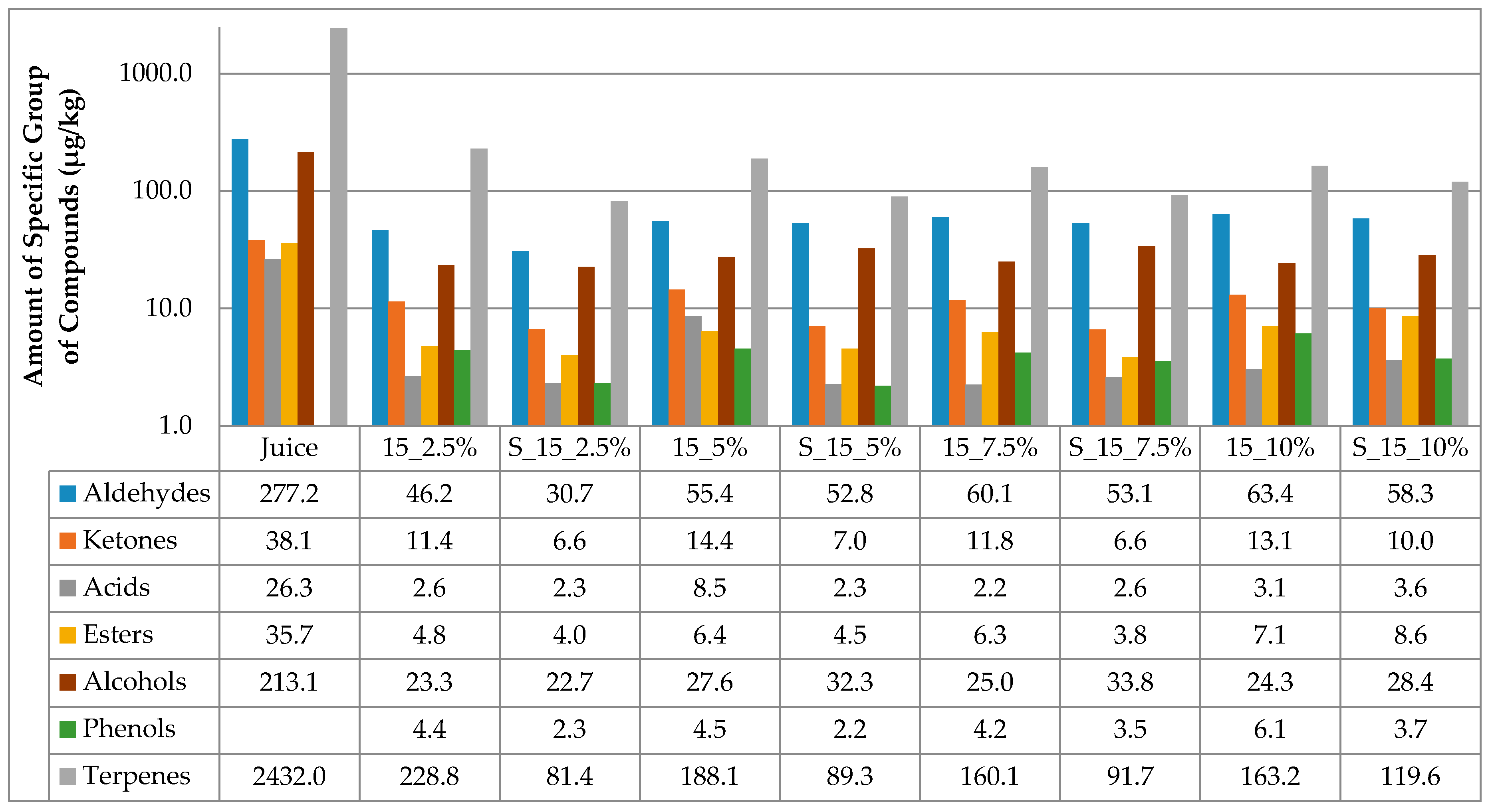
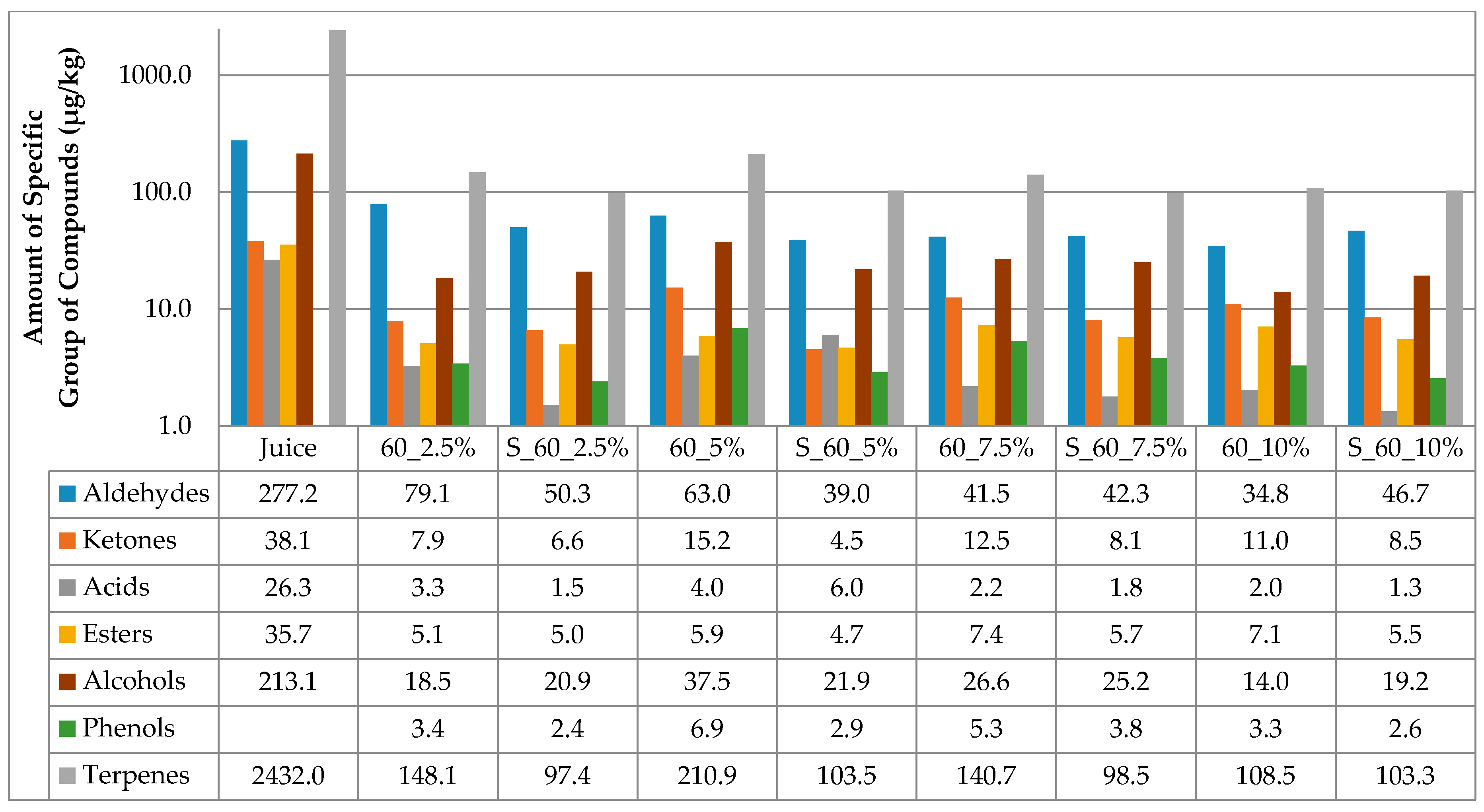
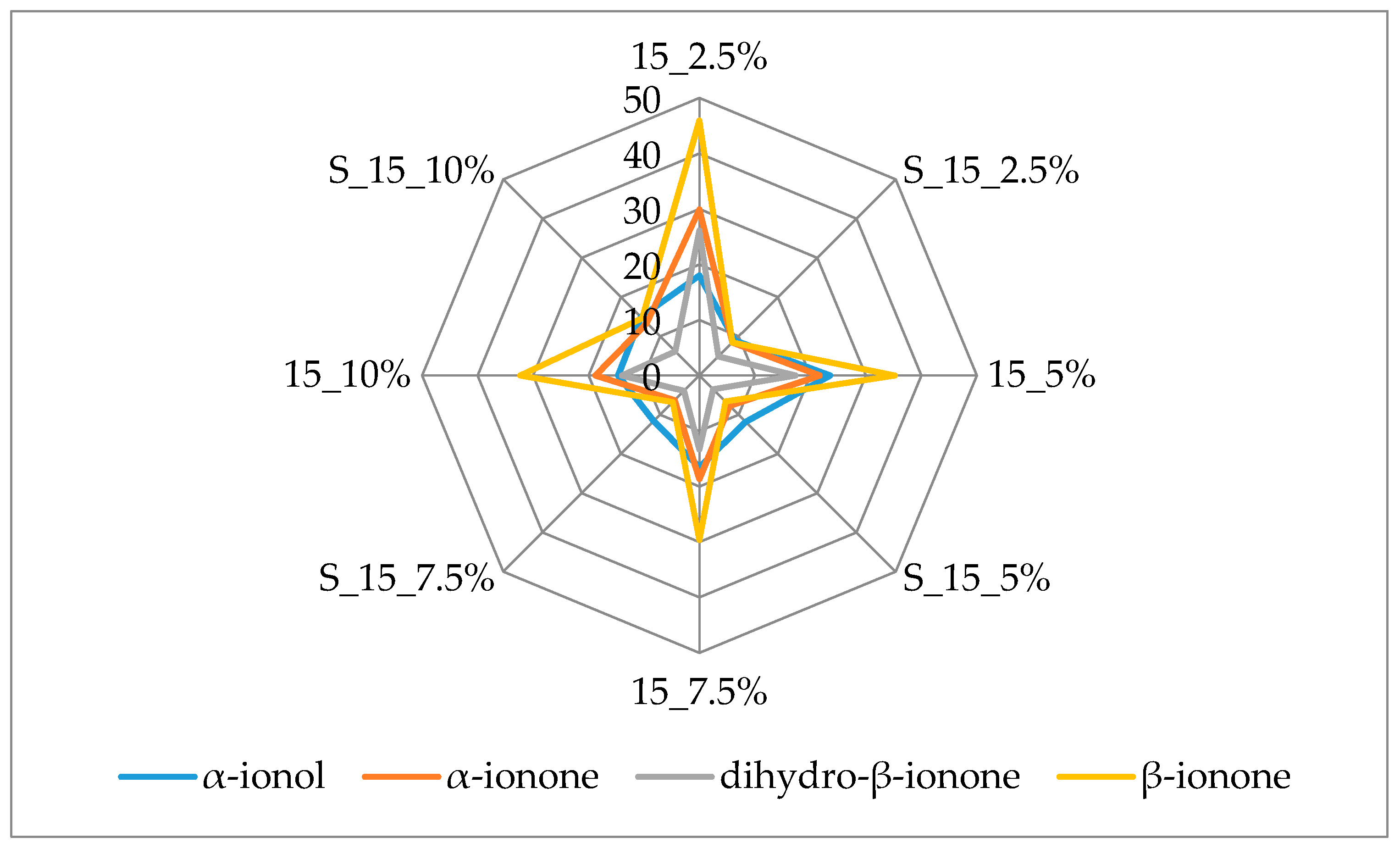

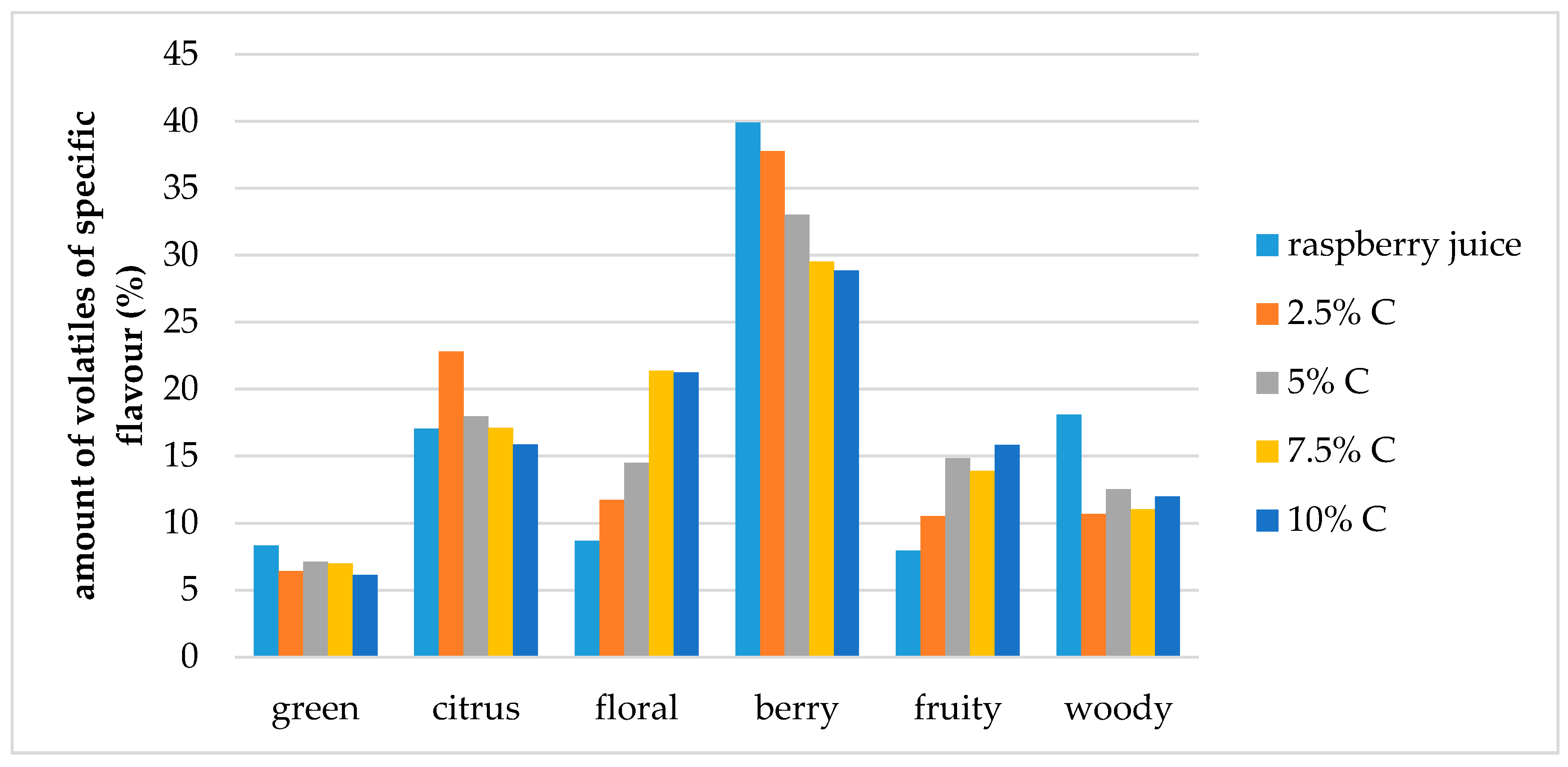
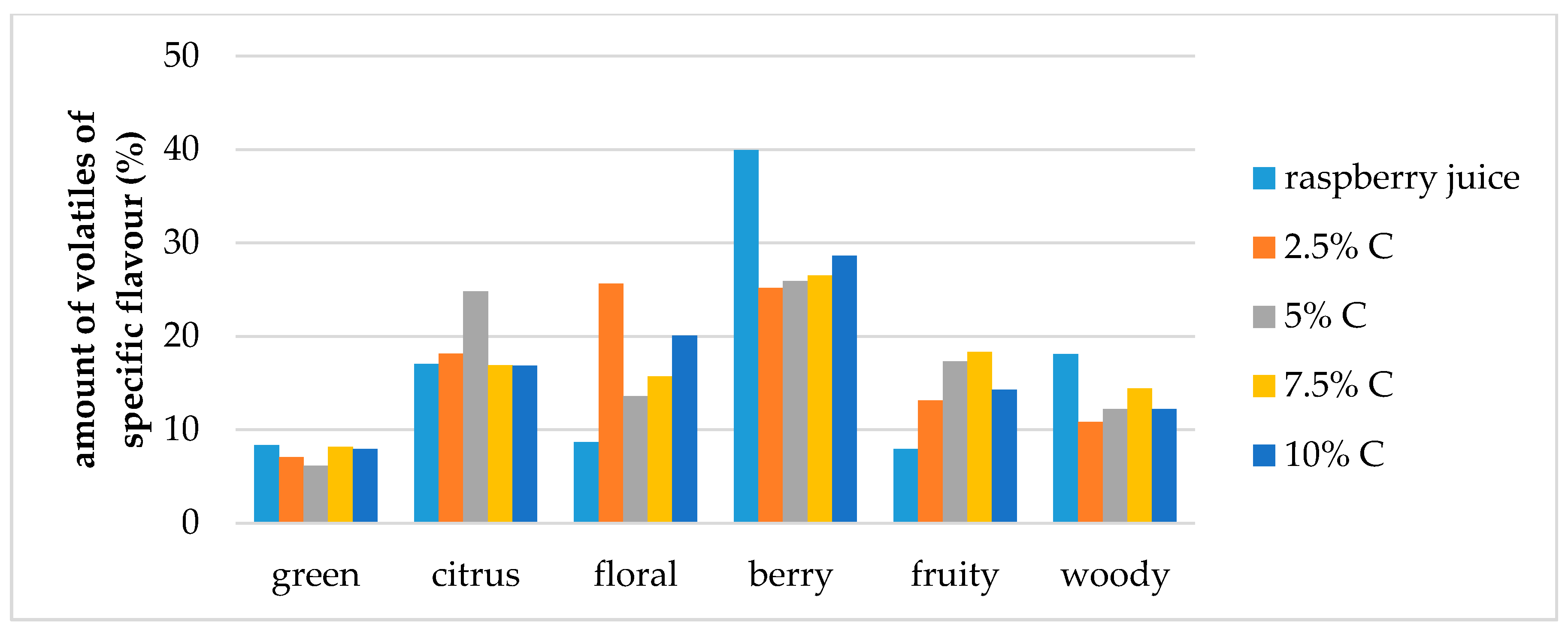
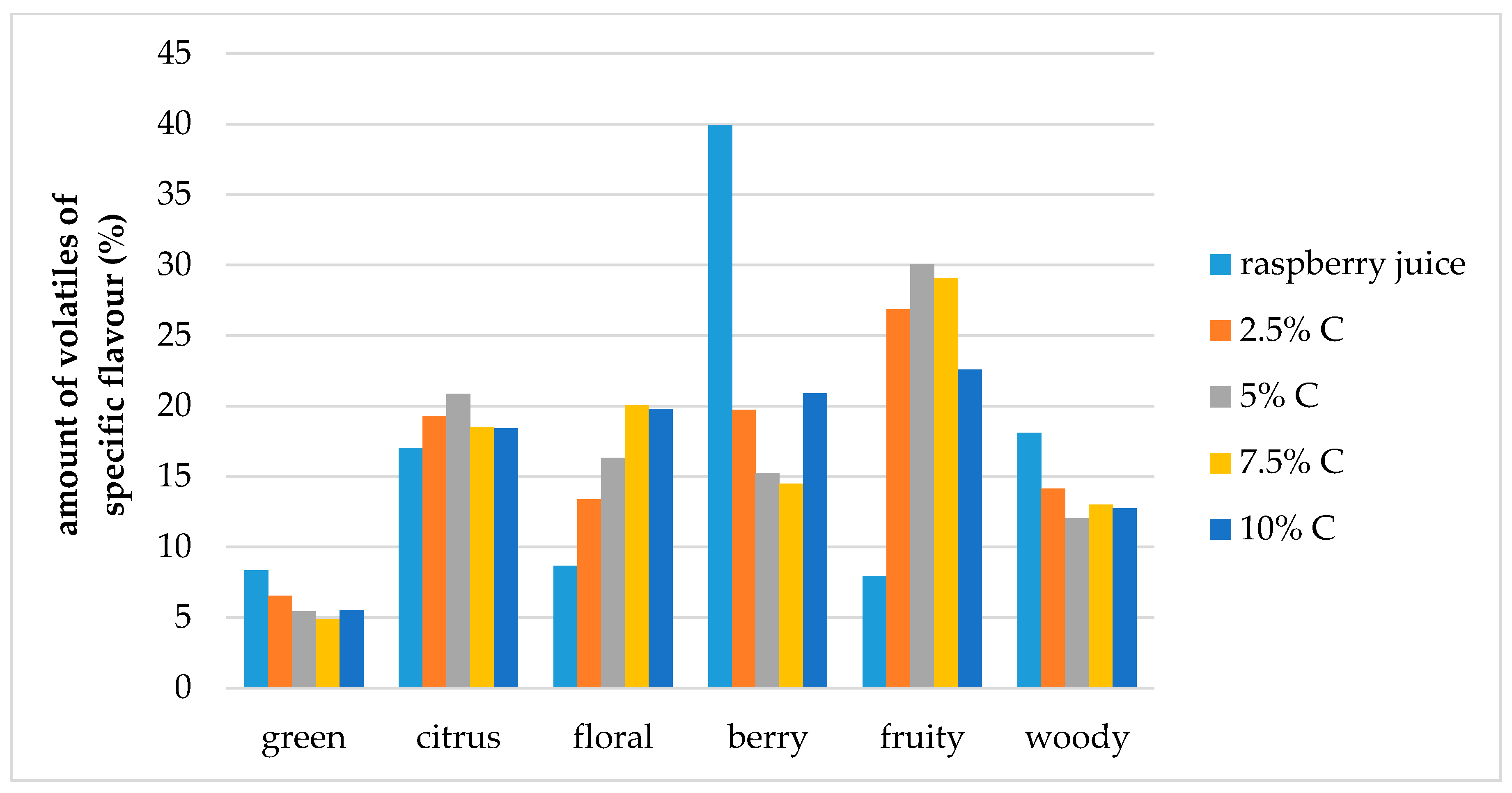
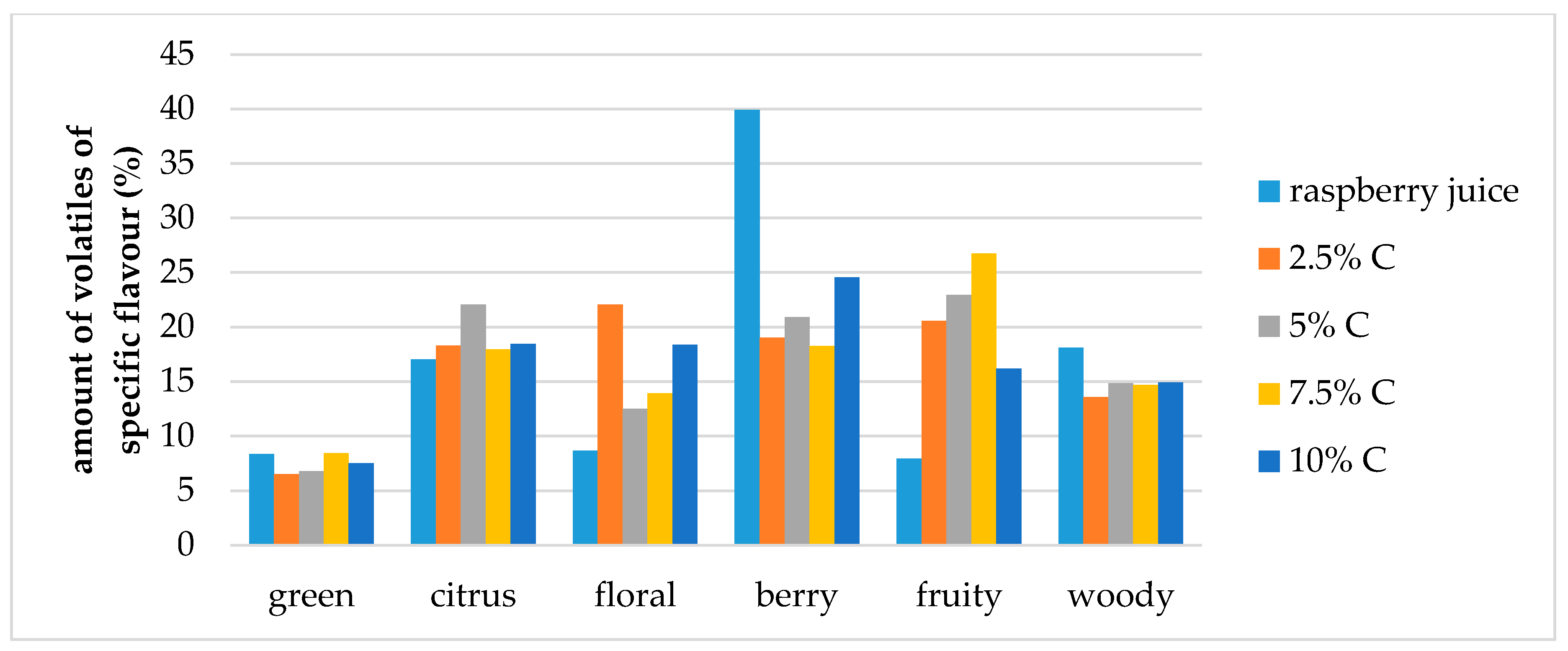
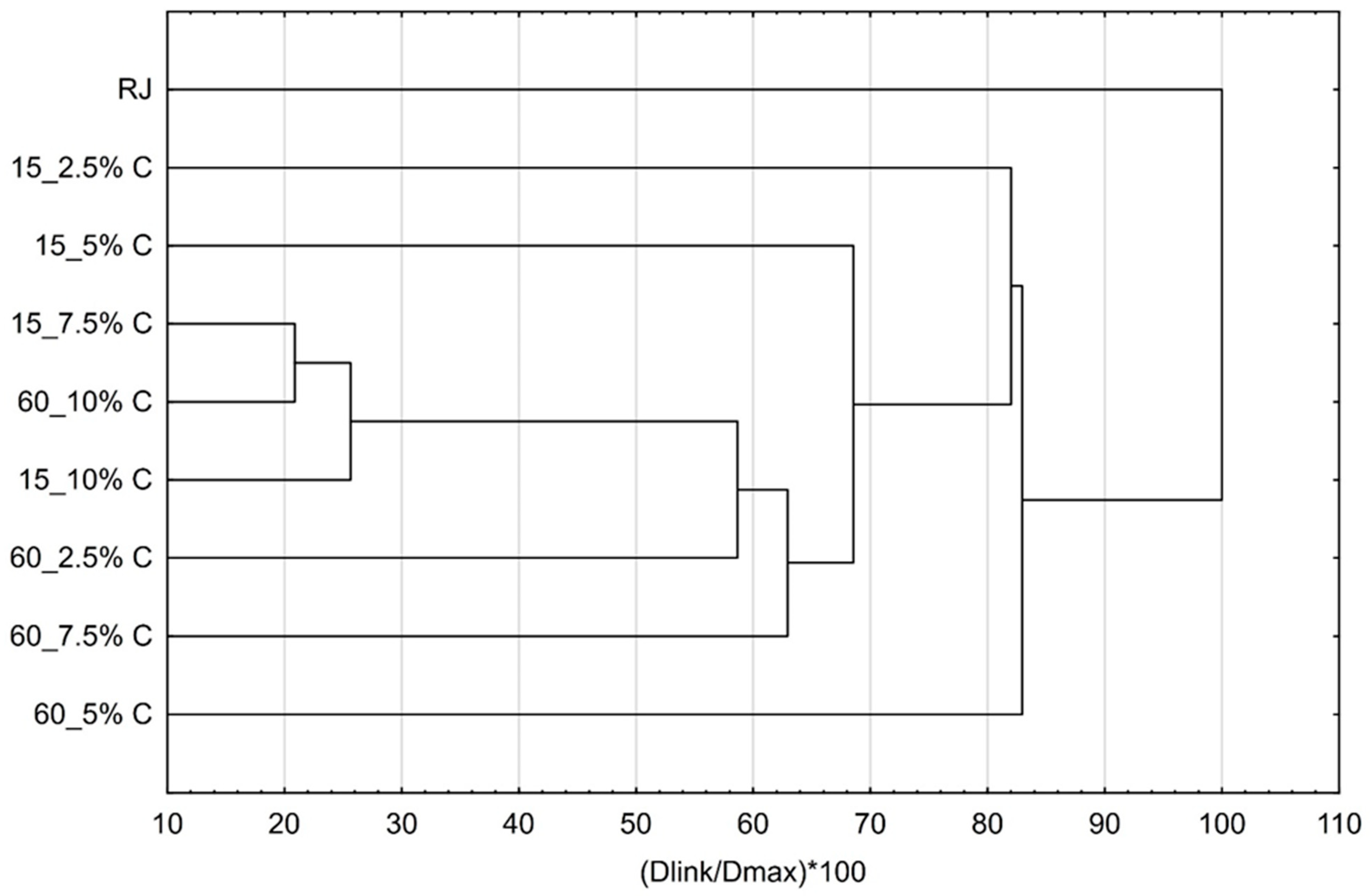
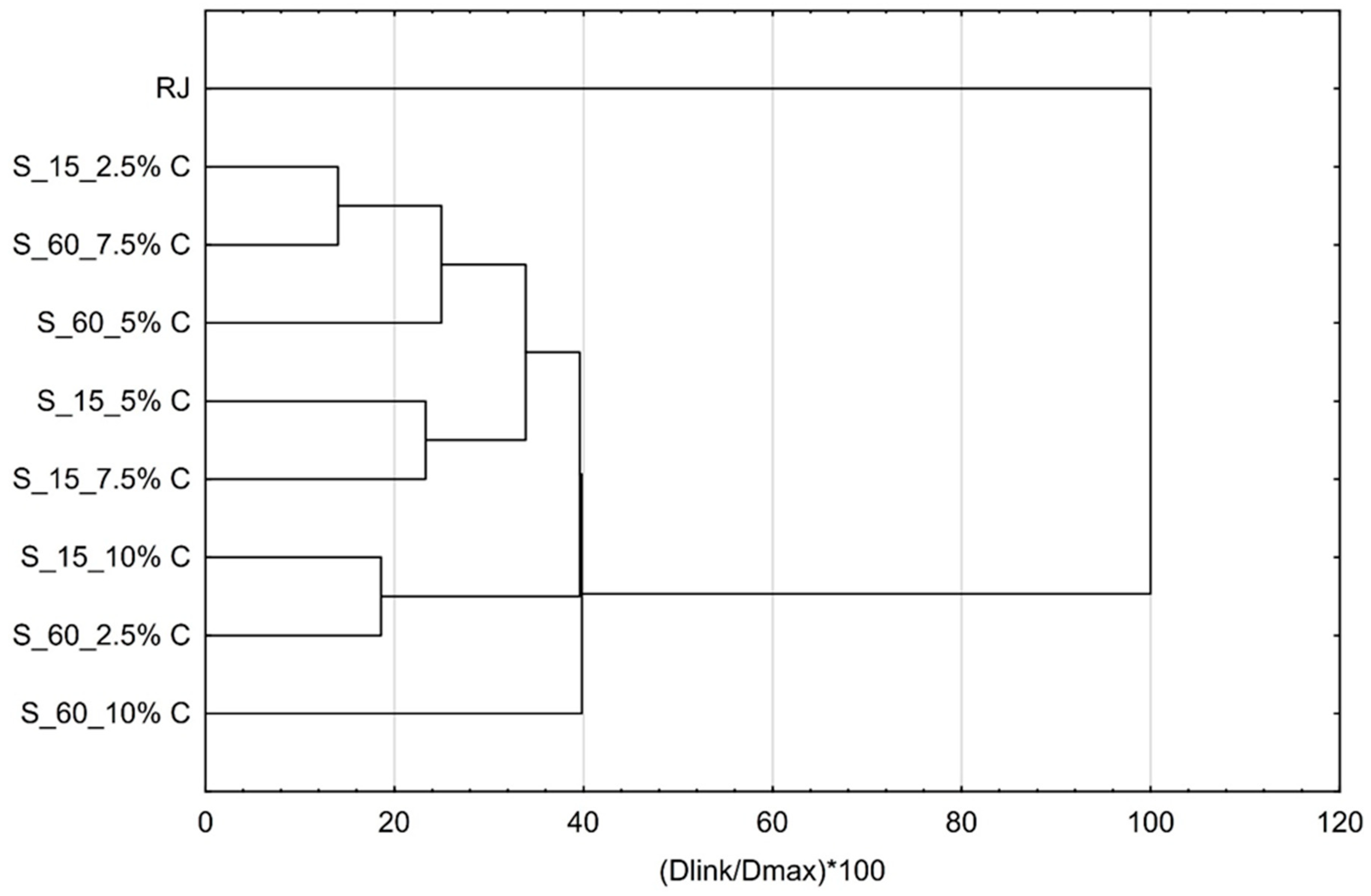
| Juice | Complex * | RT (min) 1 | RI 2 | MW 3 | log P (o/w) 4 | Vapor Pressure (mm/Hg) | Odor Description |
|---|---|---|---|---|---|---|---|
| 2-hexenal | + | 7.4716 | 851 | 98.14 | 1.79 | 4.62 | green |
| hexanol | - | 8.5358 | 866 | 102.18 | 2.03 | 0.947 | green |
| benzaldehyde | + | 14.8880 | 955 | 106.124 | 1.480 | 1.27 | fruity |
| β-myrcene | - | 17.1058 | 987 | 136.238 | 4.17 | 2.29 | woody |
| octanal | + | 18.0072 | 998 | 128.22 | 2.951 | 2.068 | green |
| hexanoic acid | - | 18.7302 | 1009 | 116.16 | 1.920 | 0.158 | fruity |
| limonene | + | 19.3232 | 1018 | 136.238 | 4.57 | 0.198 | citrus |
| 2-ethyl hexanol | + | 19.8268 | 1029 | 130.231 | 2.82 | 0.207 | fruity |
| benzyl alcohol | - | 20.1599 | 1035 | 108.139 | 1.100 | 0.094 | fruity |
| γ-terpinene | - | 21.1997 | 1051 | 136.238 | 4.5 | 1.075 | citrus |
| 1-phenylethanone | + | 21.6789 | 1057 | 120.151 | 1.58 | 0.397 | fruity |
| linalool oxide | + | 22.0851 | 1065 | 170.252 | 1.375 | 0.002 | floral |
| octanol | - | 22.2638 | 1071 | 130.23 | 3.0 | 0.079 | green |
| - | guaiacol | 23.1329 | 1080 | 124.139 | 1.32 | 0.179 | woody |
| α-terpinolene | + | 23.8974 | 1094 | 136.238 | 4.470 | 1.126 | woody |
| linalool | + | 23.8884 | 1096 | 154.252 | 2.970 | 0.016 | citrus |
| nonanal | + | 24.1158 | 1095 | 142.242 | 3.461 | 0.532 | citrus |
| ethyl hexanoic acid | + | 25.8217 | 1128 | 144.214 | 2.640 | 0.03 | no flavor |
| 2-nonenal | + | 27.0726 | 1155 | 140.226 | 3.319 | 0.256 | green |
| - | menthol | 27.6494 | 1167 | 156.27 | 3.216 | 0.032 | green |
| α-terpineol | + | 28.4620 | 1180 | 154.253 | 2.67 | 0.028 | woody |
| myrtenol | + | 28.7553 | 1185 | 152.24 | 3.22 | 0.018 | green |
| decanal | + | 29.4771 | 1200 | 156.269 | 3.97 | 0.207 | floral |
| ethyl benzaldehyde | 29.672 | 1201 | 134.178 | 2.408 | 0.106 | fruity | |
| β-cyclocitral | - | 29.9239 | 1207 | 152.237 | 3.10 | 0.176 | herbal |
| nerol | + | 30.5818 | 1218 | 154.253 | 3.47 | 0.013 | citrus |
| geraniol | + | 31.9384 | 1247 | 154.253 | 3.56 | 0.021 | floral |
| 4-propyl benzaldehyde | + | 32.4908 | 1261 | 148.20 | 2.918 | 0.039 | no flavor |
| vitispirane | - | 32.7283 | 1265 | 192.302 | 3.62 | 0.022 | floral |
| - | decanol | 32.7995 | 1265 | 158.28 | 4.570 | 0.008510 | fruity |
| - | nonanoic acid | 33.5062 | 1277 | 158.23 | 3.42 | 0.009 | waxy |
| α-ionol | + | 37.4621 | 1376 | 194.317 | 4.492 | 0.001 | berry |
| β-damascenone | + | 37.6571 | 1380 | 190.286 | 4.04 | 0.02 | woody |
| ethyl decanoate | + | 38.0311 | 1389 | 200.322 | 4.861 | 0.034 | fruity |
| trans-caryophyllene | - | 38.5426 | 1402 | 204.356 | 6.777 | 0.013 | woody |
| α-ionone | + | 38.9487 | 1417 | 192.302 | 3.995 | 0.014 | berry |
| dihydro β-ionone | + | 39.2249 | 1432 | 194.317 | 3.990 | 0.01 | berry |
| dihydro-β-ionol | + | 39.4117 | 1440 | 196.33 | 4.634 | 0.001 | floral |
| geranyl acetone | + | 39.6066 | 1448 | 194.318 | 3.834 | 0.016 | floral |
| β-ionone | + | 4.3458 | 1477 | 192.302 | 3.995 | 0.017 | berry |
| myristicin | - | 41.0120 | 1511 | 192.214 | 2.586 | 0.008 | woody |
| lilial | + | 41.0691 | 1514 | 204.313 | 4.216 | 0.005 | floral |
| - | α-cedrol | 42.4579 | 1592 | 222.372 | 4.33 | 0.001 | woody |
| myristyl aldehyde | - | 42.4825 | 1601 | 212.376 | 6.008 | 0.006 | woody |
| - | benzophenone | 42.799 | 1618 | 182.222 | 3.1 | 0.001 | floral |
| methyl dihydrojasmonate | + | 43.1727 | 1647 | 226.316 | 2.653 | 0.001 | floral |
| - | hexyl salicylate | 43.4814 | 1667 | 222.284 | 5.07 | 0.00049 | green |
| hexyl cinnamaldehyde | + | 44.3590 | 1737 | 216.324 | 4.866 | 0.001 | floral |
| Compounds | Juice | 2.5% | 5% | 7.5% | 10% | ||||
|---|---|---|---|---|---|---|---|---|---|
| Time of Complexation | - | 15 | 60 | 15 | 60 | 15 | 60 | 15 | 60 |
| Aldehydes | |||||||||
| 2-hexenal | 37.44 ± 0.05 a | 0.22 ± 0.00 d | 1.53 ± 0.05 b | 0.20 ± 0.03 d | 0.57 ± 0.08 c | - | 0.57 ± 0.03 c | 0.22 ± 0.04 d | 0.25 ± 0.04 d |
| benzaldehyde | 42.03 ± 1.17 a | 1.48 ± 0.00 f | 4.58 ± 0.47 c | 4.84 ± 0.87 c | 8.45 ± 0.99 b | 2.06 ± 0.07 e | 4.97 ± 0.31 c | 2.20 ± 0.40 d,e | 2.98 ± 0.32 d |
| octanal | 12.37 ± 0.39 a | 6.60 ± 0.41 b | 3.75 ± 0.24 d | 6.56 ± 1.21 b | 7.16 ± 1.56 b | 3.54 ± 0.09 d | 4.08 ± 0.13 c | 3.39 ± 0.30 d | 3.43 ± 1.23 d |
| nonanal | 27.63 ± 0.03 a | 17.02 ± 1.71 b | 12.16 ± 0.13 c | 17.16 ± 2.60 b | 18.71 ± 1.70 b | 11.05 ± 1.00 c,d | 11.78 ± 0.33 c,d | 11.44 ± 0.12 d | 8.59 ± 2.46 e |
| 2-nonenal | 4.77 ± 0.12 a | 1.16 ± 0.01 d | 1.02 ± 0.08 d | 2.33 ± 0.13 c | 2.45 ± 0.28 c | 4.01 ± 0.02 b | 1.28 ± 0.16 d | 1.24 ± 0.06 d | 0.88 ± 0.13 e |
| decanal | 39.56 ± 2.80 a | 9.75 ± 1.12 c | 38.56 ± 2.40 a | 10.07 ± 1.55 c | 10.78 ± 0.87 c,d | 25.98 ± 2.32 b | 8.19 ± 0.98 d | 22.00 ± 2.80 b | 9.59 ± 0.50 c |
| ethyl benzaldehyde | - | 1.19 ± 0.08 d | 4.38 ± 0.42 b | 1.77 ± 0.31 c | 1.31 ± 0.51 c | 4.72 ± 0.11 b | 1.12 ± 0.12 d | 5.25 ± 0.01 a | 1.02 ± 0.32 d |
| 4-propyl benzaldehyde | 92.06 ± 0.58 a | 4.15 ± 0.36 d | 7.44 ± 0.90 c | 7.50 ± 0.86 c | 7.65 ± 1.28 c | 4.21 ± 0.59 d | 4.43 ± 0.08 d | 11.30 ± 0.73 b | 2.89 ± 0.27 e |
| lilial | 8.64 ± 0.03 a | 2.74 ± 0.05 c | 2.84 ± 0.73 b,c | 2.77 ± 0.35 b,c | 3.31 ± 0.50 b | 2.35 ± 0.30 c | 2.61 ± 0.34 b,c | 3.30 ± 0.46 b | 2.34 ± 0.90 b,c |
| hexyl cinnamaldehyde | 4.07 ± 0.12 a | 1.91 ± 0.03 f | 2.81 ± 0.06 b,c | 2.22 ± 0.05 d | 2.65 ± 0.13 c,e | 2.14 ± 0.29 d,f | 2.44 ± 0.10 d,e | 3.10 ± 0.26 b | 2.82 ± 0.48 b,c |
| Ketones | |||||||||
| 1-phenylethanone | 9.30 ± 0.18 a | 3.53 ± 0.24 c | 1.02 ± 0.04 f | 2.19 ± 0.16 d | 4.43 ± 0.12 b | 1.71 ± 0.48 e | 1.35 ± 0.15 e | 2.27 ± 0.18 d | 0.94 ± 0.32 f |
| geranyl acetone | 28.77 ± 0.10 a | 6.29 ± 0.49 d,e | 6.89 ± 1.22 d,f | 10.18 ± 1.41 b | 8.94 ± 1.46 b,c,f | 8.26 ± 0.72 b,c,f | 7.60 ± 0.15 c,f | 7.87 ± 0.93 c,f | 7.70 ± 1.26 c,e,f |
| benzophenone | - | 1.61 ± 0.13 e | 2.52 ± 0.50 b,c | 2.05 ± 0.07 d | 1.82 ± 0.41 d,e | 1.79 ± 0.45 d,e | 3.54 ± 0.39 a | 2.91 ± 0.40 a,b | 2.39 ± 0.47 c |
| Esters | |||||||||
| methyl dihydrojasmonate | 6.94 ± 0.08 a | 1.63 ± 0.21 d | 3.06 ± 0.08 d | 3.33 ± 0.38 c | 3.23 ± 0.06 c | 1.41 ± 0.12 a | 4.59 ± 0.26 b | 3.44 ± 0.38 c | 2.73 ± 0.66 c |
| hexyl salicylate | - | 3.17 ± 0.03 b | 2.05 ± 0.27 c | 3.08 ± 0.26 b | 2.63 ± 0.27 c | 4.91 ± 0.84 a | 2.76 ± 0.52 a | 3.66 ± 0.65 a | 4.39 ± 0.67 a |
| Acids | |||||||||
| hexanoic acid | 22.44 ± 0.42 | - | - | - | - | - | - | - | - |
| ethyl hexanoic acid | 3.84 ± 0.28 a | 1.22 ± 0.12 b | - | 0.41 ± 0.04 d | - | 0.72 ± 0.08 c | - | 0.76 ± 0.30 c | - |
| nonanoic acid | - | 1.41 ± 0.13 f | 3.26 ± 0.45 c | 8.12 ± 0.94 a | 4.00 ± 0.06 b | 1.51 ± 0.44 e,f | 2.19 ± 0.14 d | 2.29 ± 0.09 d | 2.04 ± 0.25 d,e |
| Alcohols | |||||||||
| hexanol | 83.19 ± 0.43 | - | - | - | - | - | - | - | - |
| 2-ethyl hexanol | 37.99 ± 2.88 a | 21.21 ± 0.48 b | 16.07 ± 0.20 c | 25.21 ± 4.33 b | 35.09 ± 2.76 a | 22.06 ± 0.55 b | 24.56 ± 0.13 b | 20.98 ± 2.23 b | 11.98 ± 0.77 d |
| benzyl alcohol | 10.12 ± 0.02 | - | - | - | - | - | - | - | - |
| octanol | 81.78 ± 2.57 | - | - | - | - | - | - | - | - |
| decanol | - | 2.12 ± 0.35 b | 2.38 ± 0.29 b | 2.36 ± 0.30 b | 2.38 ± 0.05 b | 2.93 ± 0.52 a | 2.08 ± 0.34 b | 3.28 ± 0.48 a | 2.02 ± 0.53 b |
| Phenols | |||||||||
| guaiacol | - | 4.38 ± 0.14 b | 3.43 ± 0.35 d | 4.53 ± 0.55 b | 6.88 ± 0.72 a | 4.19 ± 0.73 b,e | 5.34 ± 0.51 b | 6.09 ± 0.05 a | 3.30 ± 0.70 d,e |
| Terpenes | |||||||||
| limonene | 33.83 ± 1.33 a | 8.72 ± 0.54 b | 2.99 ± 0.09 d | 2.61 ± 0.10 e | 4.78 ± 0.53 c | 3.08 ± 0.39 d | 3.01 ± 0.35 d | 3.38 ± 0.61 d | 1.80 ± 0.77 e |
| γ-terpinene | 5.76 ± 0.11 | ||||||||
| linalool oxide | 17.79 ± 0.38 a | 1.16 ± 0.09 f | 0.99 ± 0.03 f | 1.79 ± 0.12 e | 1.73 ± 0.24 e | 5.36 ± 0.26 c | 1.69 ± 0.14 e | 5.98 ± 0.16 b | 2.81 ± 0.64 d |
| α-terpinolene | 48.79 ± 0.47 a | 1.67 ± 0.32 b | 0.92 ± 0.14 d,e | 1.20 ± 0.05 c | 1.13 ± 0.16 c | 0.91 ± 0.003 d | 0.94 ± 0.06 d | 0.84 ± 0.16 e | 0.51 ± 0.13 f |
| linalool | 418.56 ± 17.99 a | 44.22 ± 1.52 c | 31.70 ± 1.18 d,f | 31.64 ± 4.89 d,f | 57.52 ± 3.28 b | 29.53 ± 0.60 d,f | 24.46 ± 3.46 e | 26.97 ± 3.78 e,f | 19.17 ± 1.34 g |
| menthol | - | 4.94 ± 0.11 a,c | 6.23 ± 0.31 a | 4.58 ± 0.71 a,b | 4.40 ± 0.66 b | 4.01 ± 0.27 b | 6.66 ± 1.67 a | 5.10 ± 0.03 a | 4.20 ± 0.85 b |
| α-terpineol | 374.22 ± 28.12 a | 22.27 ± 3.26 b,d | 17.33 ± 1.85 c | 24.16 ± 4.70 b,d | 28.05 ± 3.91 b | 19.59 ± 1.30 c | 23.24 ± 1.96 b | 19.63 ± 1.23 c,d | 12.98 ± 1.31 e |
| myrtenol | 35.23 ± 2.12 a | 5.62 ± 0.22 b | 3.00 ± 0.60 e | 4.96 ± 0.16 c | 3.13 ± 0.46 e | 4.19 ± 0.31 d | 2.20 ± 1.46 e,f | 2.85 ± 0.02 e | 2.02 ± 0.07 f |
| nerol | 34.69 ± 0.75 a | 2.41 ± 0.002 c | 1.15 ± 0.03 f,g | 1.78 ± 0.29 e | 3.21 ± 0.20 b | 1.59 ± 0.43 e,g | 1.64 ± 0.18 e | 2.03 ± 0.19 d | 1.18 ± 0.17 f,g |
| geraniol | 118.55 ± 3.39 a | 8.47 ± 0.53 c | 6.23 ± 1.24 d,e | 7.23 ± 0.72 c,d | 9.90 ± 0.63 b | 5.31 ± 0.27 e | 4.57 ± 0.28 f | 6.27 ± 0.81 d | 3.59 ± 0.63 f |
| vitispirane | 16.67 ± 0.14 | - | - | ||||||
| α-ionol | 362.34 ± 31.83 a | 18.01 ± 0.80 c | 14.60 ± 1.07 d | 23.53 ± 3.88 b | 19.75 ± 1.51 b,c | 16.53 ± 0.82 c | 17.29 ± 2.70 c | 14.66 ± 0.16 d | 12.68 ± 1.19 e |
| β-damascenone | 38.74 ± 1.81 a | 2.72 ± 0.02 c | 1.96 ± 0.22 d,e | 3.08 ± 0.49 b | 2.65 ± 0.47 c | 2.02 ± 0.03 d | 2.36 ± 0.44 c,d | 2.24 ± 0.27 c,d | 1.59 ± 0.36 e |
| trans-caryophyllene | 36.80 ± 1.27 | - | |||||||
| α-ionone | 339.30 ± 8.32 a | 29.90 ± 0.67 b | 14.96 ± 1.71 d | 21.70 ± 2.61 c | 21.62 ± 1.43 c | 18.63 ± 2.79 c | 12.92 ± 0.95 d | 18.74 ± 2.16 c | 10.75 ± 0.02 e |
| dihydro-β-ionone | 152.40 ± 2.12 a | 26.13 ± 1.40 b | 11.32 ± 1.49 d,e | 17.32 ± 1.99 c | 12.61 ± 2.80 d | 13.30 ± 2.12 d | 9.51 ± 1.15 e | 13.97 ± 1.69 d | 6.85 ± 1.37 f |
| dihydro-β-ionol | 23.91 ± 0.12 a | 3.75 ± 0.09 b | 3.89 ± 0.81 b | 3.28 ± 0.37 b | 3.72 ± 0.56 b | 3.93 ± 0.52 b | 2.73 ± 0.04 c | 3.84 ± 0.61 b | 2.63 ± 0.36 c |
| β-ionone | 365.89 ± 20.27 a | 45.90 ± 0.20 b | 25.75 ± 4.60 d,e | 35.20 ± 4.35 c | 33.98 ± 6.29 c | 29.64 ± 3.75 c,d | 24.45 ± 2.85 d,e | 32.31 ± 4.07 c | 21.91 ± 0.44 e |
| myristicine | 8.51 ± 0.15 | - | - | ||||||
| α-cedrol | - | 2.89 ± 0.20 b | 5.03 ± 1.02 a | 4.06 ± 0.19 a | 2.76 ± 0.40 b | 2.52 ± 0.002 b | 2.98 ± 0.53 b,c | 4.36 ± 0.84 a | 3.87 ± 0.60 a,c |
| Compounds | 2.5% | 5% | 7.5% | 10% | ||||
|---|---|---|---|---|---|---|---|---|
| Time of Complexation | 15 | 60 | 15 | 60 | 15 | 60 | 15 | 60 |
| Aldehydes | ||||||||
| 2-hexenal | - | - | - | - | - | - | ||
| benzaldehyde | 4.45 ± 0.03 e | 4.77 ± 0.47 d | 6.33 ± 0.01 a | 5.22 ± 0.07 c | 5.08 ± 0.11 c,d | 4.89 ± 0.20 d | 5.48 ± 0.09 b | 4.69 ± 0.17 d |
| octanal | 2.44 ± 0.02 b | 1.49 ± 0.11 e | 1.91 ± 0.01 c | 2.46 ± 0.06 b | 2.81 ± 0.12 a | 2.80 ± 0.16 a | 3.01 ± 0.14 a | 1.74 ± 0.01 d |
| nonanal | 7.00 ± 0.05 f | 6.37 ± 0.35 g | 13.94 ± 0.08 a | 8.60 ± 0.25 d | 8.05 ± 0.17 e | 9.73 ± 0.33 c | 12.57 ± 0.24 b | 9.11 ± 0.42 c,d |
| 2-nonenal | 0.94 ± 0.01 c | 0.53 ± 0.05 e | 1.94 ± 0.01 a | 0.91 ± 0.02 c | 1.26 ± 0.04 b | 0.81 ± 0.00 d | 0.99 ± 0.01 c | 0.95 ± 0.08 c |
| decanal | 7.00 ± 0.01 d | 20.85 ± 0.66 a | 13.78 ± 1.42 b | 4.41 ± 0.17 e | 20.93 ± 0.99 a | 4.10 ± 0.24 e | 20.65 ± 0.75 a | 7.61 ± 0.21 c |
| ethyl benzaldehyde | 0.99 ± 0.01 d | 2.28 ± 0.20 a | 1.73 ± 0.01 b | 0.92 ± 0.08 d | 2.52 ± 0.02 a | 1.07 ± 0.12 d | 2.57 ± 0.12 a | 1.30 ± 0.01 c |
| 4-propyl benzaldehyde | 6.72 ± 0.04e | 10.23 ± 0.01 d | 11.82 ± 0.37 c | 12.45 ± 0.15 b | 10.68 ± 0.21 d | 13.66 ± 1.23 b | 11.68 ± 0.26 c | 15.39 ± 0.43 a |
| lilial | - | 2.14 ± 0.09 d | - | 2.64 ± 0.16 c | - | 3.11 ± 0.06 b | - | 3.35 ± 0.04 a |
| hexyl cinnamaldehyde | 1.18 ± 0.01 e | 1.60 ± 0.22 c,d | 1.38 ± 0.09 d | 1.37 ± 0.04 d | 1.73 ± 0.06 c | 2.13 ± 0.19 b | 2.30 ± 0.08 b | 2.57 ± 0.03 a |
| Ketones | ||||||||
| 1-phenylethanone | 1.10 ± 0.03 | - | - | - | - | - | - | - |
| geranyl acetone | 4.43 ± 0.20 d | 5.14 ± 0.67 c | 5.57 ± 0.03 c | 3.22 ± 0.16 e | 4.81 ± 0.09 d | 5.49 ± 0.04 c | 7.49 ± 0.30 a | 6.22 ± 0.14 b |
| benzophenone | 1.10 ± 0.04 c | 1.45 ± 0.06 b | 1.45 ± 0.08 b | 1.32 ± 0.08 b | 1.79 ± 0.01 b | 2.63 ± 0.34 a | 2.55 ± 0.05 a | 2.30 ± 0.10 a |
| Esters | ||||||||
| methyl dihydrojasmonate | 1.44 ± 0.13 g | 2.48 ± 0.00 d | 2.08 ± 0.05 e | 2.37 ± 0.02 d | 1.84 ± 0.14 f | 3.04 ± 0.03 b | 4.83 ± 0.09 a | 2.71 ± 0.03 c |
| hexyl salicylate | 2.52 ± 0.05 c | 2.51 ± 0.16 c | 2.45 ± 0.01 c | 2.32 ± 0.14 c | 1.99 ± 0.01 d | 2.70 ± 0.24 b | 3.80 ± 0.16 s | 2.83 ± 0.11 b |
| Acids | ||||||||
| ethyl hexanoic acid | 1.10 ± 0.02 b | - | 0.59 ± 0.00 c | - | 1.57 ± 0.11 a | - | 1.15 ± 0.07 b | - |
| nonanoic acid | 1.19 ± 0.10 e | 1.52 ± 0.09 c | 1.66 ± 0.04 c | 6.03 ± 0.07 a | 1.02 ± 0.03 e | 1.79 ± 0.21 c | 2.45 ± 0.15 b | 1.34 ± 0.07 d |
| Alcohols | ||||||||
| 2-ethyl hexanol | 21.48 ± 0.46 e | 19.40 ± 0.64 f | 30.78 ± 0.04 b | 20.69 ± 0.51 e,f | 32.06 ± 0.18 a | 23.92 ± 0.42 d | 26.00 ± 0.48 c | 17.27 ± 0.14 g |
| decanol | 1.18 ± 0.01 f | 1.45 ± 0.05 d | 1.48 ± 0.03 d | 1.18 ± 0.25 d,f | 1.73 ± 0.02 c | 1.27 ± 0.20 d,f | 2.36 ± 0.06 s | 1.94 ± 0.08 b |
| Phenols | ||||||||
| guaiacol | 2.29 ± 0.02 e | 2.40 ± 0.08 d | 2.19 ± 0.00 f | 2.89 ± 0.19 c | 3.53 ± 0.01 b | 3.83 ± 0.12 a | 3.72 ± 0.06 a | 2.56 ± 0.11 c,d |
| Terpenes | ||||||||
| limonene | 1.36 ± 0.00 d | 1.57 ± 0.07 c | 1.50 ± 0.04 c | 2.63 ± 0.07 b | 2.65 ± 0.13 b | 1.17 ± 0.22 d,e | 3.80 ± 0.05 a | 0.96 ± 0.01 e |
| linalool oxide | 1.26 ± 0.01 d | 0.99 ± 0.05 e | 2.09 ± 0.04 a | 1.43 ± 0.05 c | 1.84 ± 0.02 b | 1.55 ± 0.07 c | 1.29 ± 0.06 d | 1.53 ± 0.07 c |
| α-terpinolene | 0.64 ± 0.01 a,b | 0.73 ± 0.07 a | 0.77 ± 0.00 a | 0.75 ± 0.04 a | 0.57 ± 0.03 b | 0.67 ± 0.02 a,b | 0.71 ± 0.00 a | 0.62 ± 0.03 b |
| linalool | 20.75 ± 0.38 d | 24.59 ± 0.41 a | 23.61 ± 0.16 b | 26.78 ± 2.89 a | 24.94 ± 1.06 a | 22.20 ± 0.69c | 25.64 ± 0.10 a | 20.71 ± 2.30 bd |
| menthol | 2.84 ± 0.14 e | 5.31 ± 0.45 b | 2.87 ± 0.09 e | 3.95 ± 0.01 c | 2.25 ± 0.00 f | 7.64 ± 0.39 a | 3.20 ± 0.12 d | 5.44 ± 0.35 b |
| α-terpineol | 15.67 ± 0.65 c | 16.98 ± 1.30 b,c | 17.32 ± 0.42 c | 19.99 ± 0.39 a | 18.32 ± 0.11 b | 20.36 ± 0.82 a | 20.02 ± 0.53 a | 18.38 ± 0.02 b |
| myrtenol | 1.44 ± 0.02 c | 2.05 ± 0.24 a,b | 1.42 ± 0.04 c | 2.29 ± 0.24 a | 1.38 ± 0.08 c | 2.05 ± 0.15 a,b | 1.97 ± 0.07 b | 2.04 ± 0.00 a,b |
| nerol | 0.85 ± 0.00 d | 0.91 ± 0.11 c,d | 1.55 ± 0.03 a | 0.91 ± 0.12 c,d | 0.97 ± 0.00 c | 0.94 ± 0.05 c | 1.18 ± 0.08 b | 1.22 ± 0.08 b |
| geraniol | 2.64 ± 0.08 e | 3.05 ± 0.06 d | 3.35 ± 0.10 c | 3.14 ± 0.24 c,d | 3.73 ± 0.03 b | 2.07 ± 0.19 f | 4.21 ± 0.13 a | 2.65 ± 0.03 e |
| α-ionol | 8.96 ± 0.11 c | 5.87 ± 4.68 d | 11.81 ± 0.43 b | 12.29 ± 1.53 b | 11.64 ± 0.07 b | 14.94 ± 0.78 a | 14.92 ± 0.48 a | 15.62 ± 1.10 a |
| β-damascenone | 1.13 ± 0.04 d | 1.55 ± 0.01 a | 1.19 ± 0.05 d | 1.09 ± 0.12 d | 1.12 ± 0.04 d | 1.17 ± 0.04 d | 1.43 ± 0.04 b | 1.27 ± 0.05 c |
| α-ionone | 8.38 ± 0.11 c | 9.51 ± 0.63 b | 7.70 ± 0.04 d | 9.58 ± 0.40 b | 6.34 ± 0.10 f | 6.89 ± 0.10 e | 13.38 ± 0.88 a | 9.94 ± 0.47 b |
| dihydro-β-ionone | 4.85 ± 0.00 c | 6.95 ± 0.48 a | 3.50 ± 0.09 e | 2.95 ± 0.18 b | 3.94 ± 0.11 d | 3.04 ± 0.04 f | 6.15 ± 0.05 b | 4.75 ± 0.20 c |
| dihydro-β-ionol | 1.72 ± 0.01 e | 2.63 ± 0.16 b | 2.04 ± 0.04 d | 2.16 ± 0.00 c | 2.98 ± 0.08 a | 2.27 ± 0.06 c | 3.09 ± 0.24 a | 2.88 ± 0.15 a,b |
| β-ionone | 8.42 ± 0.11 d | 12.51 ± 0.65 b | 6.63 ± 0.07 e | 12.06 ± 0.96 b | 6.80 ± 0.01 e | 9.75 ± 0.64 c | 14.59 ± 0.79 a | 12.28 ± 0.94 b |
| α-cedrol | 2.21 ± 0.10 c | 3.15 ± 0.28 b | 1.94 ± 0.08 d | 1.48 ± 0.05 f | 2.18 ± 0.08 c | 1.77 ± 0.20 e | 4.01 ± 0.16 a | 3.01 ± 0.21 b |
© 2020 by the authors. Licensee MDPI, Basel, Switzerland. This article is an open access article distributed under the terms and conditions of the Creative Commons Attribution (CC BY) license (http://creativecommons.org/licenses/by/4.0/).
Share and Cite
Vukoja, J.; Pichler, A.; Ivić, I.; Šimunović, J.; Kopjar, M. Cellulose as a Delivery System of Raspberry Juice Volatiles and Their Stability. Molecules 2020, 25, 2624. https://doi.org/10.3390/molecules25112624
Vukoja J, Pichler A, Ivić I, Šimunović J, Kopjar M. Cellulose as a Delivery System of Raspberry Juice Volatiles and Their Stability. Molecules. 2020; 25(11):2624. https://doi.org/10.3390/molecules25112624
Chicago/Turabian StyleVukoja, Josipa, Anita Pichler, Ivana Ivić, Josip Šimunović, and Mirela Kopjar. 2020. "Cellulose as a Delivery System of Raspberry Juice Volatiles and Their Stability" Molecules 25, no. 11: 2624. https://doi.org/10.3390/molecules25112624
APA StyleVukoja, J., Pichler, A., Ivić, I., Šimunović, J., & Kopjar, M. (2020). Cellulose as a Delivery System of Raspberry Juice Volatiles and Their Stability. Molecules, 25(11), 2624. https://doi.org/10.3390/molecules25112624






